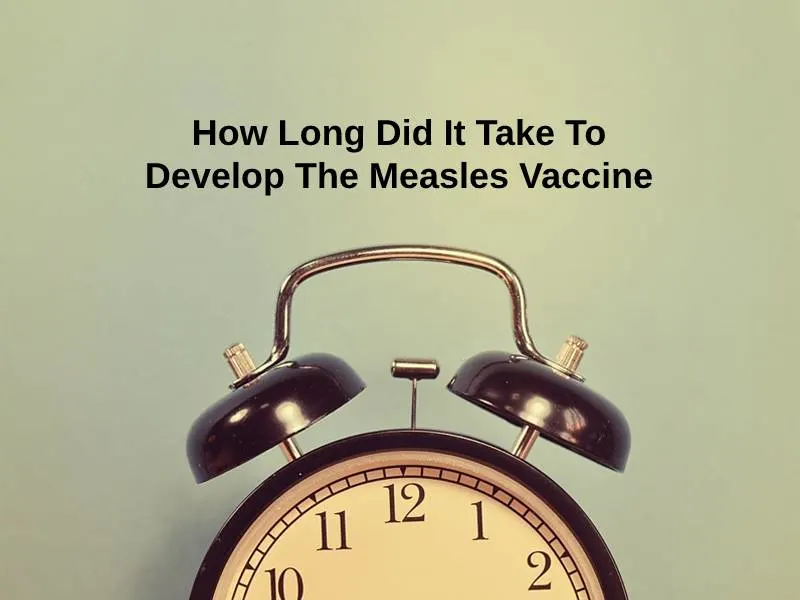Exact Answer: 2 Years
Measles is one of the 3 diseases that can be prevented by the vaccine known as MMR. The full form of this is Measles, Mumps, and Rubella. Maurice Hilleman is the one who is credited with the development of not only the measles vaccine in 1963 but also the mumps vaccine. He further created the MMR vaccine by combining the three separate vaccines in 2 years. Measles is a respiratory tract infection that is mostly seen in children. The symptoms may include cough, fever, and further a rash on the body.

How Long Did It Take To Develop The Measles Vaccine?
Measles vaccine is a type of attenuated vaccine. This means that the vaccine was developed by reducing the virulence of a certain organism so that it does not cause harm but manages to trigger the creation of antibodies so that the body develops a certain level of immunity or defense against the disease-causing organism.
The vaccine for measles was developed in different stages. The first involved it being made available and effective against the measles disease only. Further, the vaccine has been incorporated into the MMR vaccine which has the Mumps and Rubella vaccine in it. There is also the MMRV vaccine that involves the chickenpox vaccine.
The first appearance of the vaccine for measles was seen in 1963 when the Edmonston-B strain of the virus was made into a vaccine. This feat was accomplished by John Enders from the US. The next vaccine to be made available for use was developed by Maurice Hilleman in 1968. It took him 2 years to develop the vaccine. This new vaccine had a weaker pathogen, thereby making it safer for mass usage.
This vaccine is normally given to children who have completed 12 months or 1 year, in areas where measles is not common. In areas where the disease still prevails, it is advised to administer the vaccine at 9 months of age.
| Vaccine | Year |
| Edmonston-B vaccine | 1963 |
| Maurice Hilleman attenuated vaccine | 1968 |
Why Did It Take That Long To Develop The Measles Vaccine?
Measles outbreaks were fairly common at the time when the search for a vaccine had begun. It all started when John Enders, a renowned scientist who had shared a Nobel prize for the work done on the poliovirus took a particular interest in this disease.
He sent Thomas Peebles to Massachusetts, just as an outbreak of the disease was underway. Peebles manages to isolate the strain on pathogens causing the disease through blood samples of infected persons and even throat swabs. The virus was shown to be able to pass to even monkeys. Enders, based on the isolated strains sought by Peebles, managed to develop a vaccine in 1963.
The 1950s and 1960s proved to be a devastating time to contract the virus. This virus once contracted would cause rashes and other symptoms. Children below the age of 5 years hardly had a fifty percent chance of making it through with the virus.
West Africa was particularly affected very badly. The Edmonston strain vaccine was used on first a small scale and eventually on a much larger scale after the eruption of an epidemic. Nigeria was an important place where many trials took place to get the most efficient vaccine.
After a while, while trials were underway, Maurice Hilleman and partners proposed and developed a more attenuated vaccine, which involved making the virus less virulent. The development reduced the cases of diarrhea and fever tremendously. These two were a coming side effect of the vaccine. By reducing these side effects, the efficiency of the vaccine was not compromised. The new vaccine was rid of gamma globulin which helped improve its efficiency. The vaccine in its standalone form as well in its MMR form was developed by Maurice and his partners.
Conclusion
Measles is a very contagious disease which was commonly seen among young children. It is an air-borne disease that can be easily contracted. A simple cough or sneeze can transmit the disease. Once contracted, there is no cure to it, but a vaccine is available and so is supportive care. Many children did not make it after contracting the virus.
The introduction of the vaccine to combat the virus took time and a lot of contribution from all over the scientific community and those who participated in the trials. The vaccine was made by Maurice Hilleman in 1968. Although it looks like it may have taken about 5 to 7 years to develop the vaccine. The final, more attenuated vaccine took approximately 2 years.